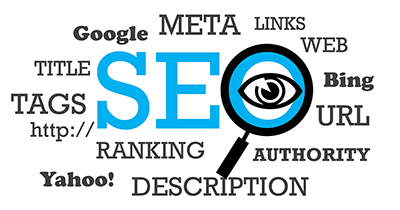Seven tips to improve your SEO
Jul 20, 2020

If you read our last module, you know how to write engaging articles. Good writing, however, is only half of the battle. The next step is to ensure that your online content reaches the right audience.
This module will help you write more successfully for the web and teach you how to employ basic SEO (search engine optimization) techniques to make your writing appeal to both living human beings and Google’s search engine robots.
Writing for Web

Did you know that reading online and reading print actually uses two different parts of the brain? When you read online, your brain tries to scan the page quickly instead of focusing deeply on the content, leading to a drop in both reading speed and comprehension.
Studies show that online readers read in an “F” pattern: reading first sentence of the first and second paragraphs and scanning the first word on the left-hand side of the rest. If they don’t find the information they’re looking for in less than 30 seconds, they’ll move on.
To get your message across online quickly, you need to know who your audience is, what information they want and how they want to receive it. For example, if you are launching a new physical literacy program for preschool-aged children in Chilliwack, your audience will probably be parents and caregivers in Chilliwack. Does your audience know what ‘physical literacy’ means? Are they interested in helping their children gain fundamental movement skills, or are they just looking for a fun, inexpensive drop-in program? Answering questions like these will help you determine what language to use.
To further adapt your writing to online audiences, you should:
- Put the most important content in the first sentences of the first two paragraphs.
- Edit your writing so that it’s as concise as possible.
- Use short sentences.
- Ensure that every single sentence is relevant to your article.
- Use headings and sub-headings to organize your information.
- Use bullet points.
- Use the 3-2-1 rule employed by many communications experts. For every 1,000 words, you should have three subheadings, two links and one photo (or other graphic).
- Put the most important keyword in the first few words of the headline.
- Think about how your words look on the page. Does your writing look pleasing to the eye?
1. What is Search Engine Optimization?

SEO is a complicated field that employs hundreds of thousands of experts. In essence, however, SEO is simply the process of making it easy for search engines to connect your content to the right audience.
Search engines work by sending “spiders” or “crawlers” across the web to pull data from billions of pages and links and store it in databases. To quickly answer your search query, search engines use an algorithm that first finds information that’s relevant to your search, and then sorts those pages by what’s the most popular. Your job is to convince the “crawlers” that your content is both relevant and popular.
2. Put down that black hat

To do that, however, you need to play by the rules. Since the invention of search engines, people have tried to game the system to drive more traffic to their site. “Black hat” search engine optimizers would stuff pages with all sorts of irrelevant keywords to trick the crawlers into thinking that the content was relevant. Now, however, search engines are smarter than ever and will penalize your site for using ‘black hat’ techniques.
Black hat techniques are also simply ineffective, since a lot of page views mean nothing if they do not help you achieve your communications objectives. It is better to have 100 people come to your tournament website and buy 50 tickets, than it is to attract 100,000 people who do not buy any tickets.
3. Why people use search engines

o improve your SEO, you first need to know why people search in the first place. Experts say that search engine queries fall into three categories:
- DO: The searcher wants to do something specific, such as sign up for a fitness class or buy tickets for a tournament.
- KNOW: The searcher wants to find out a piece of information, such as how many gold medals Canada won at the last Olympic Games.
- GO: The searcher wants to spend time browsing a particular website, such as CBC or CNN.
When you write a piece of online content, try to imagine what category it will fall under, then write accordingly.
4. What do search engines look for?

Studies have shown that the average search engine user only looks at the left-hand side of the first few links of a search. It’s therefore important to have your content ranked as high as possible for relevant search keywords.
But how do search engines determine what to show you? A search engine’s algorithm uses hundreds of factors when it sorts content, including:
- Relevancy: Does the content use the same keywords as the search term?
- Popularity: Have other users found the content useful?
- Analytics: Google uses your website’s analytics to determine how users interacted with your content.
- Content length/legibility: If your content is too long or too hard for the “crawler” to read, your site might be penalized.
- Links: Search engines have learned that good websites often link to other good websites. The more reputable sites that link to your content, the better you will be ranked. Remember: you can ask partner organizations to link to your website.
- Mentions on social media.
- Mentions of your site in the news/media/blogs.
- Currency: New content will be prioritized over content that’s stale or that has a declining number of visitors.
- Location: In some searches, search engines will prioritize local content. If, for example, I’m looking for a florist, I probably don’t want one in South Dakota if I’m in Vancouver.
5. How should I use keywords to maximize my SEO?

The days of cramming a bunch of keywords into your webpage’s metadata are over. Instead, use keywords organically in your content. Finding relevant keywords involves a bit of research and some experimentation. Here, however, are some ideas to get you started:
- Use Google Adwords’ Keyword Planner tool to find relevant keywords for your site. There are lots of other free keyword tools online.
- Conduct your own Google searches for terms that you think might be popular and see where you rank. Again, the trick is to try to use search terms that your audience will search for (“drop-in play program” not “physical literacy program.”)
- Use your own analytics to see which keywords sent the most traffic to your site.
- Consider “long tail” searches. Most people think of short, common phrases (called “short tail” searches) when they first start doing SEO. Seventy percent of searches, however, are actually “long tail” searches, meaning that they use a long string of keywords. For example, you might think it would be great to be the top site for “gymnastics” on the web, but people searching for this term could be looking for anything from information on gymnastics programs to the rules of gymnastics. A long-tail search like “gymnastics programs for boys in Burnaby”, however, will pay off greater dividends because the person searching for it is probably very keen to sign his or her child up to such a program.
6. How should I use SEO within an article?

To make it easy for crawlers to “read” your content, you should pay attention to each element of the page. Remember: you can use websites like SEO Browser to see how your website looks to search engines.
- Headline: Your headline should be shorter than 65-75 characters, since this is all that the search engine will show. Make sure to put important keywords in the beginning of your headline.
- Image alt text: When you upload an image, you can enter alternative text that will be “read” by the crawler. Use at least one keyword.
- Article: Crawlers can’t read photos, javascript, etc, so make sure that important content is in HTML. Use the “writing for web” tips listed above and organically include your keywords in the first sentence and in subheadings.
- Metadata tags: Metadata tags fields that you can fill in when you publish your article that further help crawlers to read your site. There are dozens of fields, but I have listed only the most relevant ones. Follow this link for more information on what metadata Google supports.
- Description: This bit of text appears in a search engine search below the link, so tailor it to your audience. It should be less than 160 characters.
- Keywords: Most experts say that search engines no longer look at this field, so you don’t have to fill it out.
- URL: Your URL should contain at least one of your keywords, but should also be short. Use hyphens to separate words.
7. What SEO mistakes might be hurting my organization?

If you’ve followed these basic rules, you’re on the right path. Here are just a few additional problems that sometimes cause SEO problems for sports organizations.
- Not linking up important pages: If a page isn’t linked to your homepage, the crawlers can’t reach it. Make sure that all pages on your website are clearly linked. You can use SEO-browser to make sure that all your content is visible.
- Having important content in a format that the crawlers can’t read: Crawlers can’t read forms, PDFs, and graphics, so if you use those formats, make sure to also include text in HTML.
- Duplicate content: Google’s algorithm punishes duplicate sites, which can especially hurt sports organizations. If the same content appears on your venue’s website, your PSO’s website and your NSO’s website, Google might think it’s spam and not show any of them.
- Outdated content: If the kids featured in the photos on your website’s static pages are now married with kids of their own, your website might be collecting cobwebs. Make sure to audit your website to repair dead links and refresh content so that Google knows it’s still relevant.
If you’re a busy sports communicator, you might not think that you have time for SEO. By using a few of these simple techniques, however, you can increase the number of meaningful visitors to your website and accomplish your communication goals.
Got a question about SEO? Have a tip to share? Get in the conversation by emailing or tweeting @ViasportBC.
Sources
http://www.chapterthree.com/blog/how-write-web
http://readwrite.com/2012/03/16/best_practices_for_writing_for_online_readers#awesm=~ouR1zsx5zNT17s
http://readwrite.com/2012/04/09/seo-diy-optimize-your-startups
http://readwrite.com/2011/08/10/best-seo-results-stem-from-for
http://www.nngroup.com/articles/f-shaped-pattern-reading-web-content/
https://moz.com/beginners-guide-to-seo/how-search-engines-operate
http://readwrite.com/2011/10/19/infographic-why-content-is-kin
https://moz.com/search-ranking-factors
http://adwords.google.com/keywordplanner
https://moz.com/beginners-guide-to-seo/search-engine-tools-and-services
https://moz.com/blog/category/keyword-research
http://www.bruceclay.com/blog/seo-checklist/
https://support.google.com/webmasters/answer/79812?hl=en
http://www.dal.ca/webteam/web_style_guide/writing_for_the_web.html
http://www.enchantingmarketing.com/writing-for-the-web-vs-print/





